Temperature Field in the Heat Transfer Process of PEEK Thermoplastic Composite Fiber Placement
Abstract
1. Introduction
2. Heat Transfer Model of Thermoplastic Fiber Placement
2.1. Establishment of Thermal Conductivity Equation
2.2. Heating Geometry Model and Boundary Conditions
3. Finite Element Modeling and Simulation Analysis
3.1. Finite Element Modeling and Solution of Heat Transfer Model
3.2. Finite Element Simulation Results of Temperature Field
3.2.1. Influence of Mold Temperature on the Temperature Field of the First Layer
3.2.2. The Influence of Heating Temperature on the Temperature Field of the First Layer
3.3. Influence of Heating Temperature on Temperature Field in the Substrate
4. Experimental Verification and Analysis of Temperature Field
4.1. Experimenta Set-Up
4.2. Experimental Result
5. Conclusions
Author Contributions
Funding
Conflicts of Interest
References
- Broderick, H.C.; Paul, M.W. Buckling analysis, design and optimization of variable-stiffness sandwich panels. Int. J. Solids Struct. 2016, 96, 217–228. [Google Scholar]
- Mattia, D.F.; Laura, V.; Giuseppe, D.A.; Kevin, P. Heater power control for multi-material, variable speed Automated fibre placement. Compos. Part A Appl. Sci. Manuf. 2017, 101, 408–421. [Google Scholar]
- Lukaszewicz, D.; Ward, C.; Potter, K. The engineering aspects of automated prepreg layup: History present and future. Compos. Part B Eng. 2012, 3, 997–1009. [Google Scholar] [CrossRef]
- August, Z.; Ostrander, G.; Michasiow, J. Recent developments in automated fiber placement of thermoplastic composites. SAMPE J. 2014, 50, 30–37. [Google Scholar]
- Tardif, X.; Pignon, B.; Boyard, N.; Schmelzer, J.W.; Sobotka, V.; Delaunay, D. Experimental study of crystallization of PolyEtherEtherKetone (PEEK) over a large temperature range using a nano-calorimeter. Polym. Test 2014, 36, 10–19. [Google Scholar] [CrossRef]
- Mouritz, A.P.; Leong, K.H.; Herszberg, I. A review of the effect of stitching on the inplane mechanical properties of fibre-reinforced polymer composites. Compos. Appl. Sci. Manuf. 1997, 12, 979–991. [Google Scholar] [CrossRef]
- Morey, B. Automating composites fabrication. Manuf. Eng. 2008, 4, 12–16. [Google Scholar]
- Grouve, W.J.; Warnet, L.; Akkerman, R.; Wijskamp, S.; Kok, J.S. Weld strength assessment for tape placement. Int. J. Mater. Form. 2010, 1, 707–720. [Google Scholar] [CrossRef]
- Qureshi, Z.; Swait, T.; Scaife, R.; Dessouky, H.M. In situ consolidation of thermoplastic prepreg tape using automated tape placement technology: Potential and possibilities. Compos. Part B Eng. 2014, 66, 255–267. [Google Scholar] [CrossRef]
- Pedro, R.; Hamed, A.; Andrzej, T. A review on the mechanical behaviour of curvilinear fiber composite laminates panels. J. Compos. Mater. 2013, 1, 1–17. [Google Scholar]
- Gearóid, C.; Daniël, P.; Vincenzo, O.; David, J.; Ronan, H.; Paul, W. A study of the influence of processing parameters on steering of carbon fibre/PEEK tapes using laser-assisted tape placement. Compos. Part B Eng. 2019, 163, 243–251. [Google Scholar]
- Yang, F.; Pitchumani, R. Interlaminar contact development during thermoplastic fusion bonding. Polym. Eng. Sci. 2002, 2, 424–438. [Google Scholar] [CrossRef]
- Aswani, K.B.; Gearóid, C.; Daniël, P.B.; Ronan, M.O. Properties of a thermoplastic composite skin-stiffener interface in a stiffened structure manufactured by laser-assisted tape placement with in situ consolidation. Compos. Struct. 2019, 214, 123–131. [Google Scholar]
- Dirk, H.J.; Kevin, D.P.; Jonathan, E. A concept for the in situ consolidation of thermoset matrix prepreg during automated lay-up. Compos. Part B Eng. 2013, 45, 538–543. [Google Scholar]
- Stokes, C.M.; Compston, P. Investigation of sub-melt temperature bonding of carbon-fibre/PEEK in an automated laser tape placement process. Compos. Part A Appl. Sci. 2016, 84, 17–25. [Google Scholar] [CrossRef]
- Yang, F.; Pitchumani, R. Nonisothermal healing and interlaminar bond strength evolution during thermoplastic matrix composites processing. Polym. Compos. 2003, 2, 263–278. [Google Scholar] [CrossRef]
- Dai, S.C.; Ye, L. GF/PP tape winding with on-line consolidation. J. Reinf. Plast. Compos. 2002, 21, 71–90. [Google Scholar] [CrossRef]
- Sonmez, F.O.; Hahn, H.T. Analysis of the On-Line consolidation process in thermoplastic composite tape placement. J. Thermoplast. Compos. Mater. 1997, 6, 543–572. [Google Scholar] [CrossRef]
- Mantell, S.C.; Springer, G.S. Manufacturing process models for thermoplastic composites. J. Compos. Mater. 1992, 16, 2348–2377. [Google Scholar] [CrossRef]
- Khan, M.A.; Mitschang, P.; Schledjewski, R. Identification of some optimal parameters to achieve higher laminate quality through tape placement process. Adv. Polym. Technol. 2010, 2, 98–111. [Google Scholar] [CrossRef]
- Grove, S.M. Thermal modelling of tape laying with continuous carbon fibre-reinforced thermoplastic. Composites 1988, 19, 367–375. [Google Scholar] [CrossRef]
- Kim, H.J.; Kim, S.K.; Lee, W.I. Flow and heat transfer analysis during tape layup process of APC-2 prepregs. J. Thermoplast. Compos. Mater. 2004, 17, 5–12. [Google Scholar] [CrossRef]
- Schlottermuller, M.; Lu, H.; Roth, Y. Thermal residual stress simulation in thermoplastic filament winding process. J. Thermoplast. Compos. Mater. 2003, 16, 497–519. [Google Scholar] [CrossRef]
- Rizzolo, R.H.; Walczyk, D.F. Ultrasonic consolidation of thermoplastic composite prepreg for automated fiber placement. J. Thermoplast. Compos. Mater. 2016, 29, 1480–1497. [Google Scholar] [CrossRef]
- John, T.; Gillespie, J. Modeling of in situ strength development for the thermoplastic composite tow placement process. J. Compos. Mater. 2005, 40, 1487–1506. [Google Scholar]
- Ghasemi, M.N.; Cope, R.D.; Güceri, S. Thermal analysis of in situ thermoplastic composite tape laying. J. Thermoplast. Compos. 1991, 1, 20–45. [Google Scholar] [CrossRef]
- Lionetto, F.; DellAnna, R.; Montagna, F. Modeling of continuous ultrasonic impregnation and consolidation of thermoplastic matrix composites. Compos. Part A Appl. Sci. 2016, 82, 119–129. [Google Scholar] [CrossRef]
- Dipa, R.; Anthony, J.; John, L. Fracture toughness of carbon fiber/polyether ether ketone composites manufactured by autoclave and laser-assisted automated tape placement. J. Appl. Polym. Sci. 2015, 5, 643–653. [Google Scholar]
- Stokes, M.; Compston, P. The effect of processing temperature and placement rate on the short beam strength of carbon fiber-PEEK manufactured using a laser tape placement process. Compos. Part A Appl. Sci. 2015, 78, 274–283. [Google Scholar] [CrossRef]
- Stokes, C.M.; Compston, P. A combined optical-thermal model for nearinfrared laser heating of thermoplastic composites in an automated tape placement process. Compos. Part A Appl. Sci. Manuf. 2015, 75, 104–115. [Google Scholar] [CrossRef]
- Li, Y.H.; Fu, H.Y.; Han, Z.Y. Simulation of non-isothermal crystallization kinetics of thermoplastics during fiber placement process. Polym. Polym. Compos. 2012, 1, 145–149. [Google Scholar] [CrossRef]
- John, T.; John, W.; Gillespie, J. Modeling of heat transfer and void dynamics for the thermoplastic composite tow-placement process. J. Compos. Mater. 2003, 37, 1745–1760. [Google Scholar]
- Fazil, O.; Sonmez, H.; Thomas, H. Modeling of heat transfer and crystallization in thermoplastic composite tape placement process. J. Thermoplast. Compos. Mater. 1997, 10, 198–220. [Google Scholar]
- Noha, H.; Joseph, E.; Thompson, R. A heat transfer analysis of the fiber placement composite manufacturing process. J. Reinf. Plast. Comp. 2005, 24, 869–887. [Google Scholar]
- Chinesta, F.; Leygue, A.; Bognet, B. First steps towards an advanced simulation of composites manufacturing by automated tape placement. Int. J. Mater. Form. 2014, 7, 81–92. [Google Scholar] [CrossRef]
- Toso, Y.M.; Ermanni, P.; Poulikakos, D. Thermal phenomena in fiber-reinforced thermoplastic tape winding process: Computational simulations and experimental validations. J. Compos. Mater. 2004, 38, 107–135. [Google Scholar] [CrossRef]
- Guan, X.; Pitchumani, R. Modeling of spherulitic crystallization in thermoplastic towplacement process: Heat transfer analysis. Compos. Sci. Technol. 2004, 64, 1123–1134. [Google Scholar] [CrossRef]
- Tumkor, S.; Turkmen, N.; Chassapis, C. Modeling of heat transfer in thermoplastic composite tape lay-up manufacturing. Heat Mass Transf. 2001, 12, 49–58. [Google Scholar] [CrossRef]
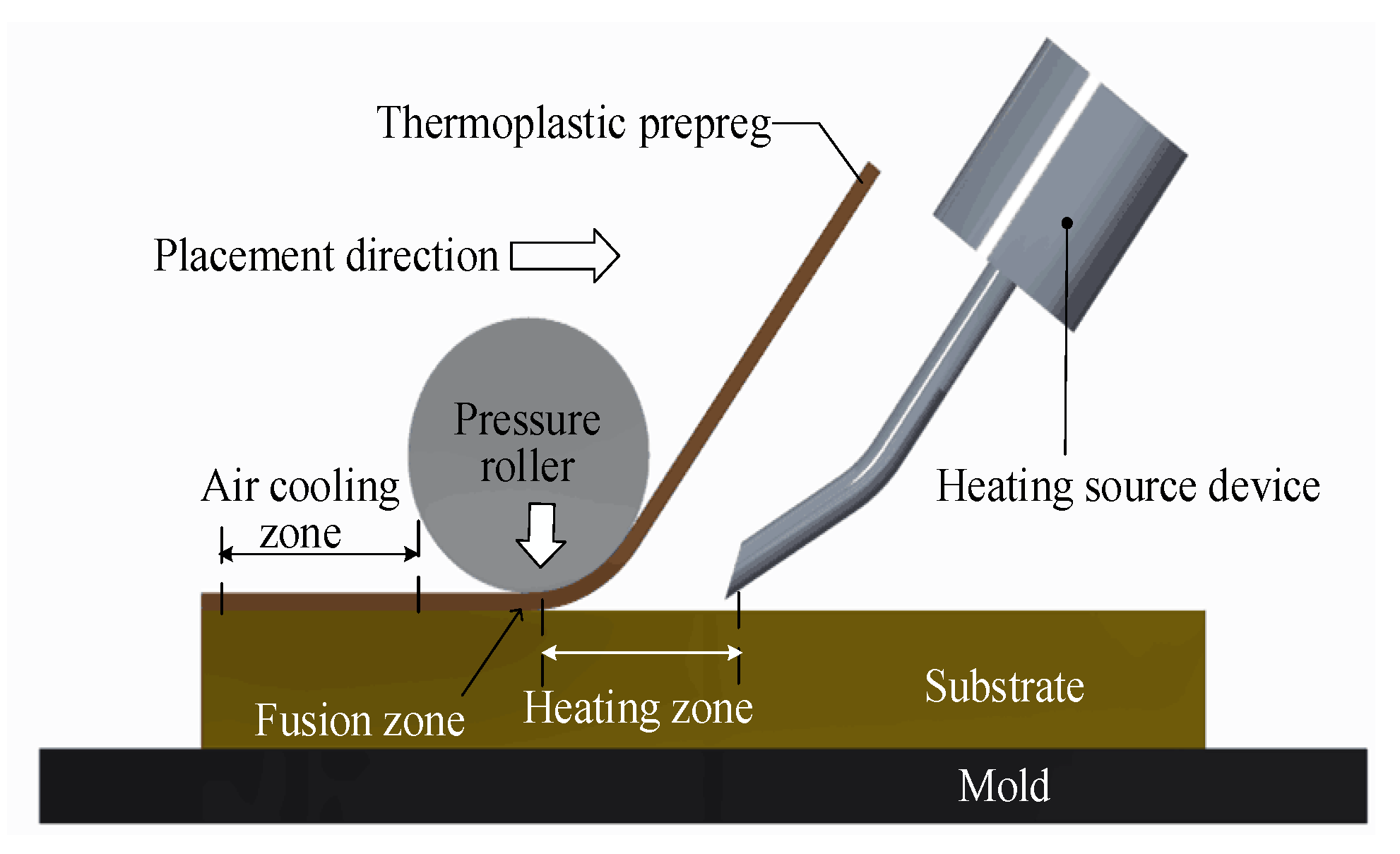

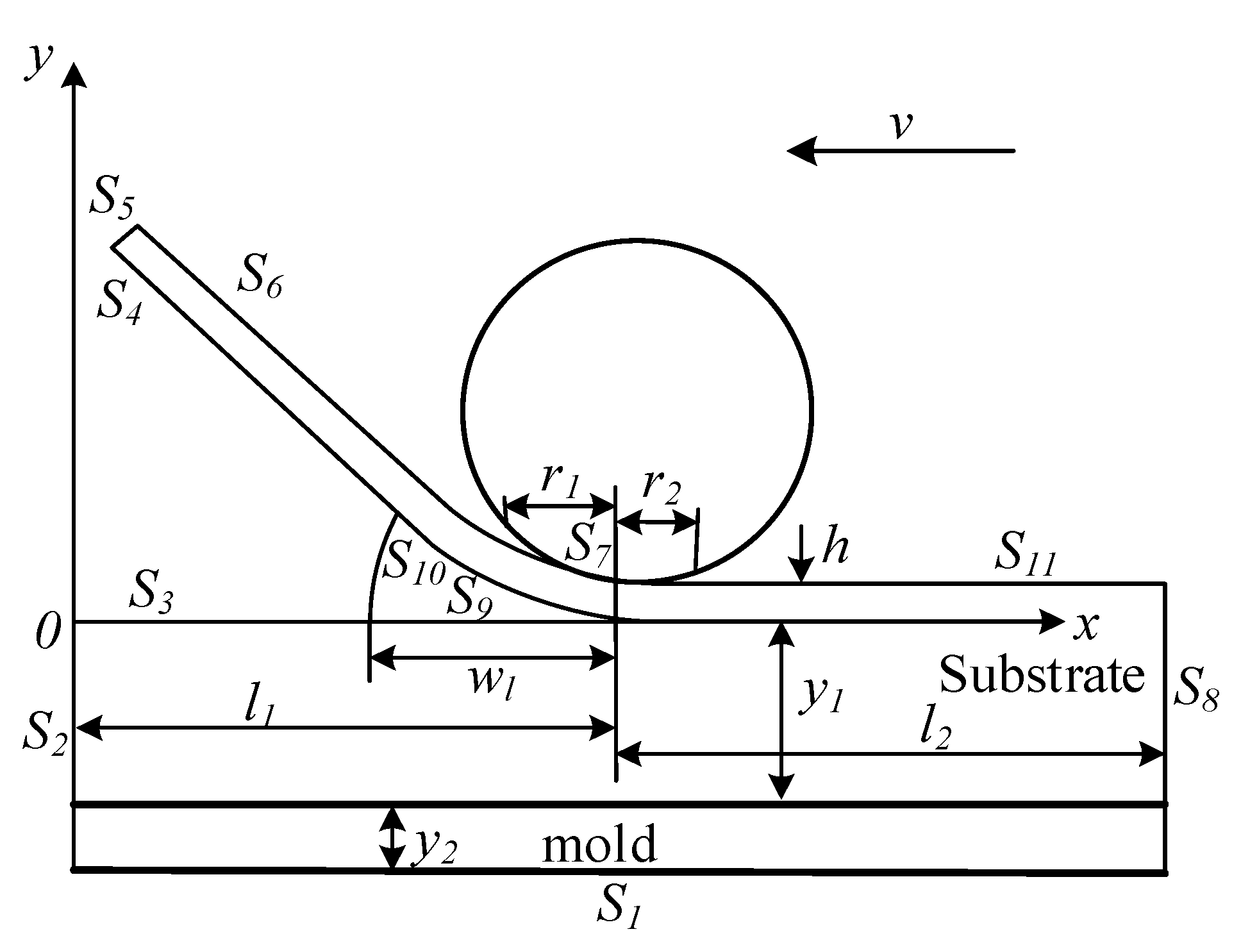
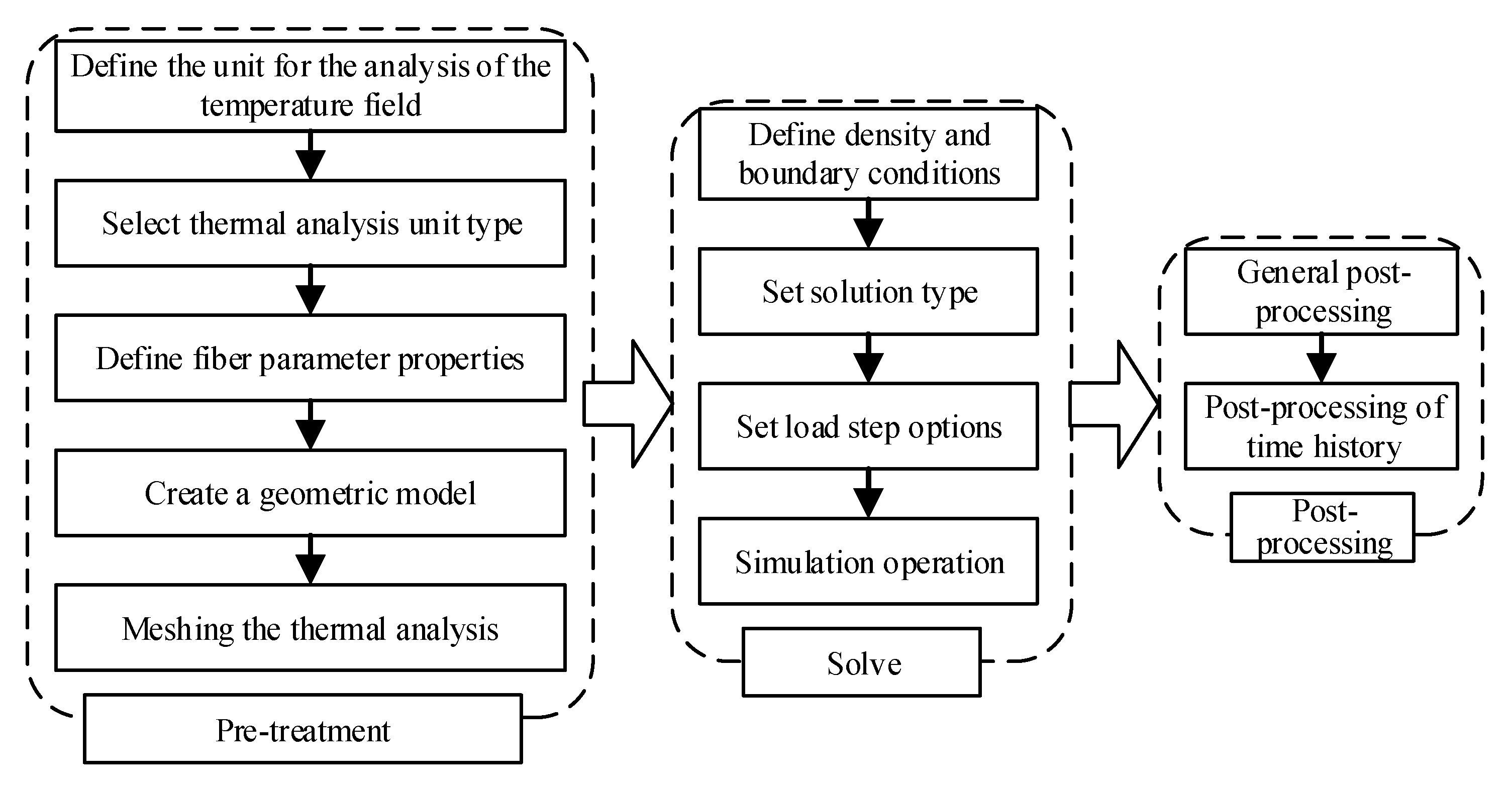
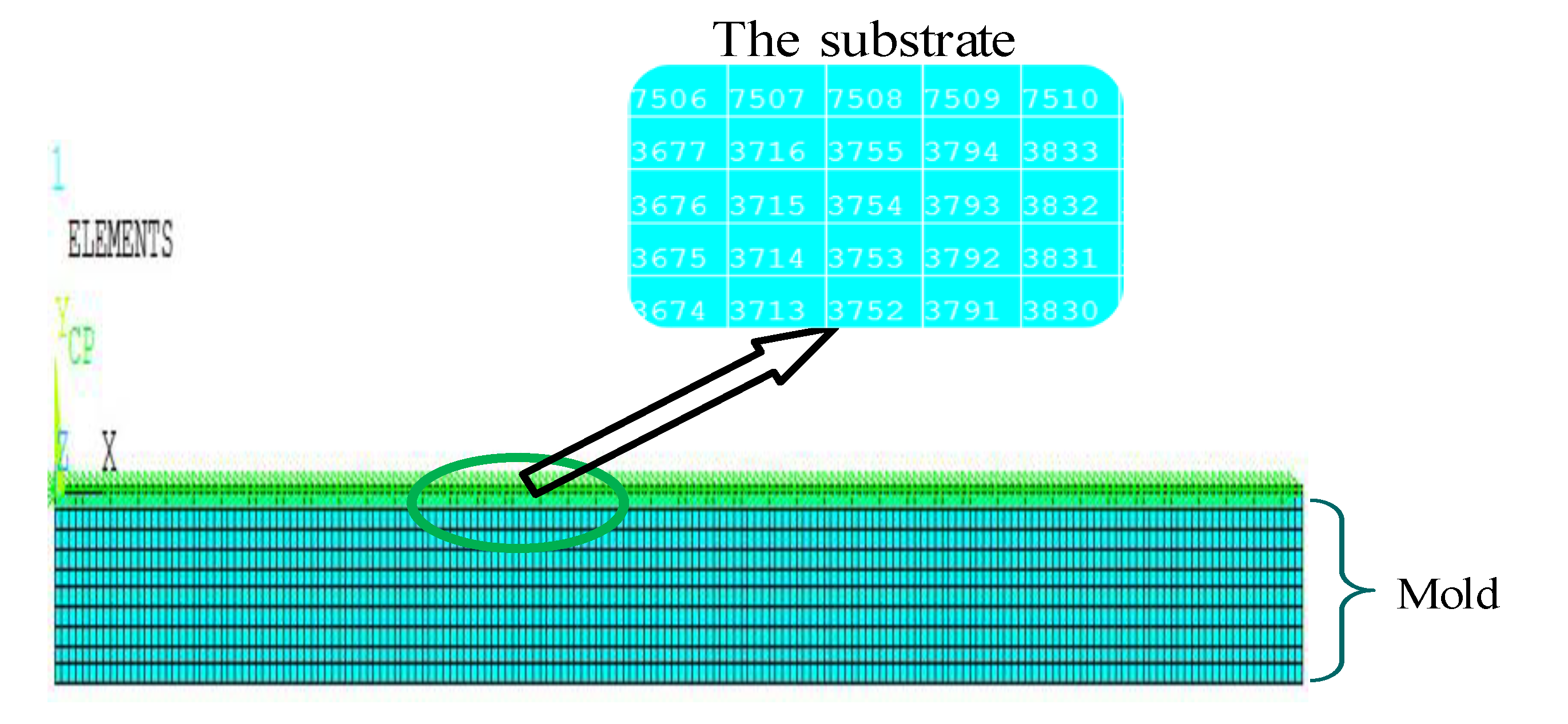

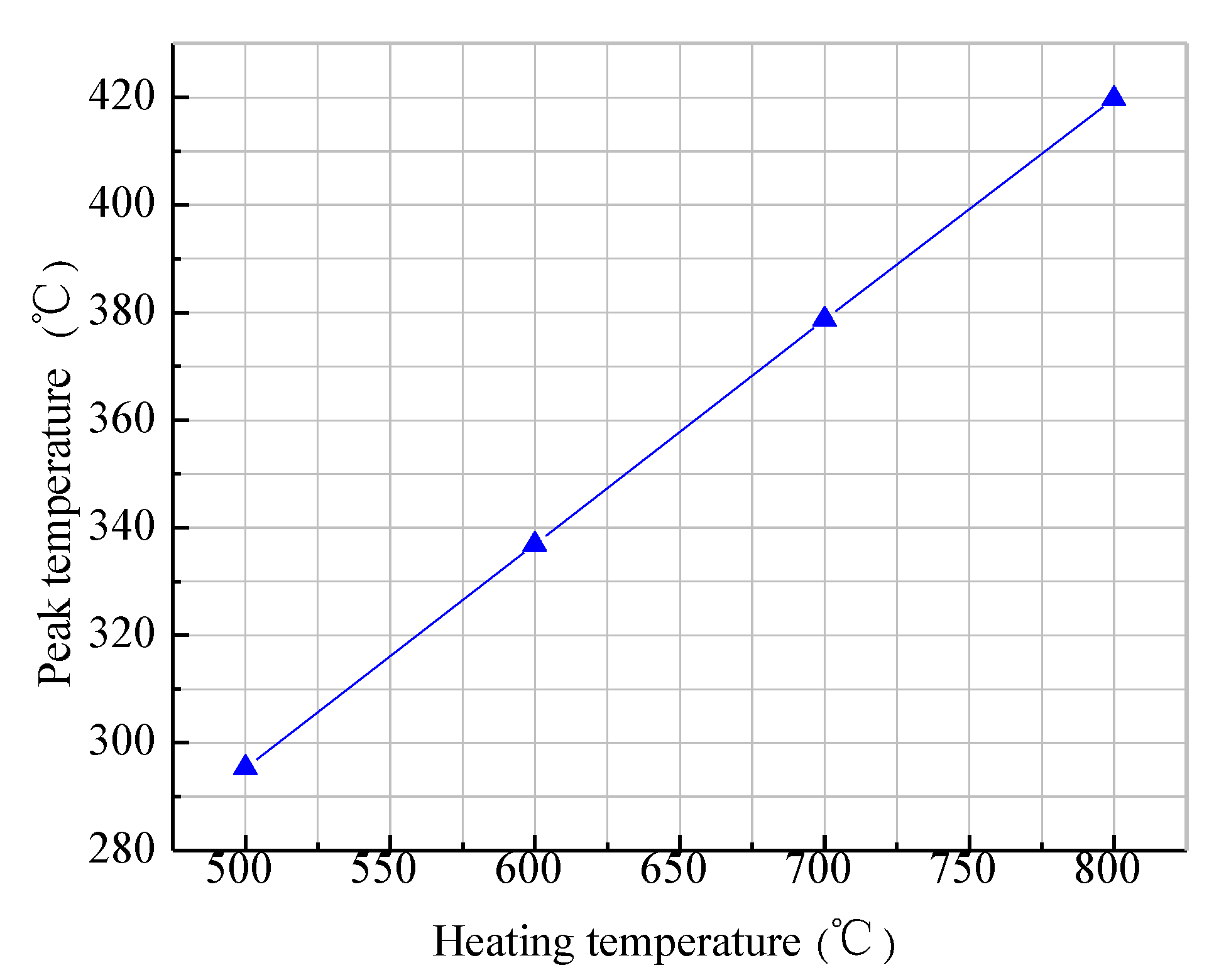
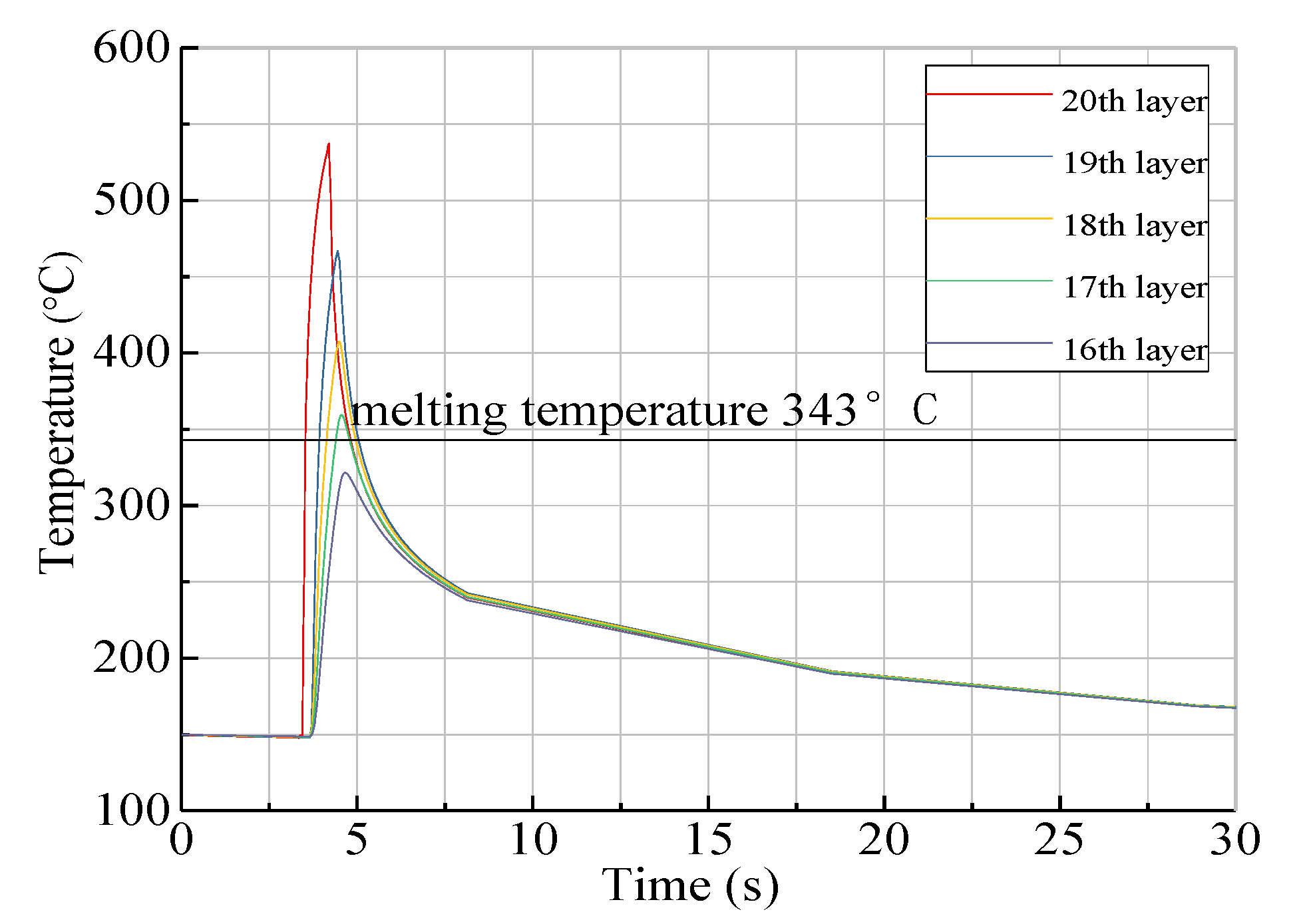

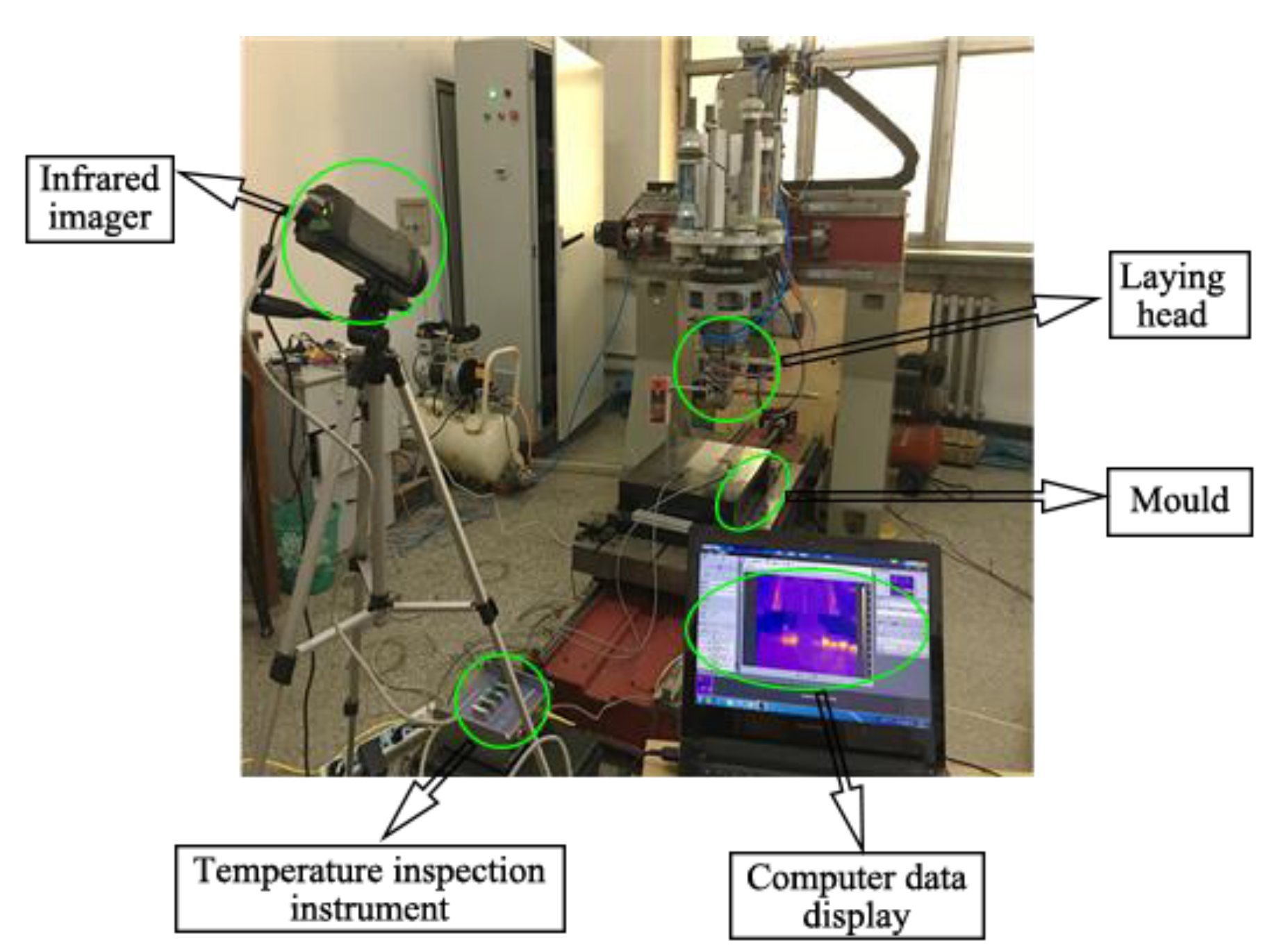
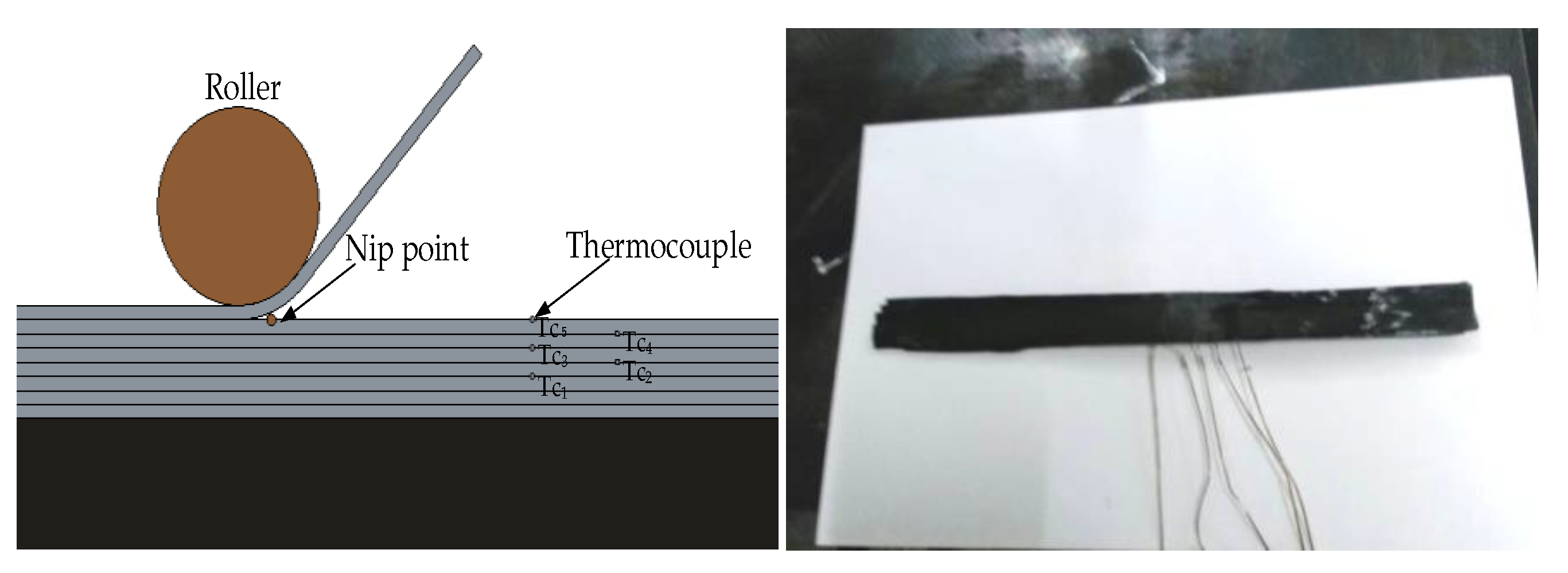
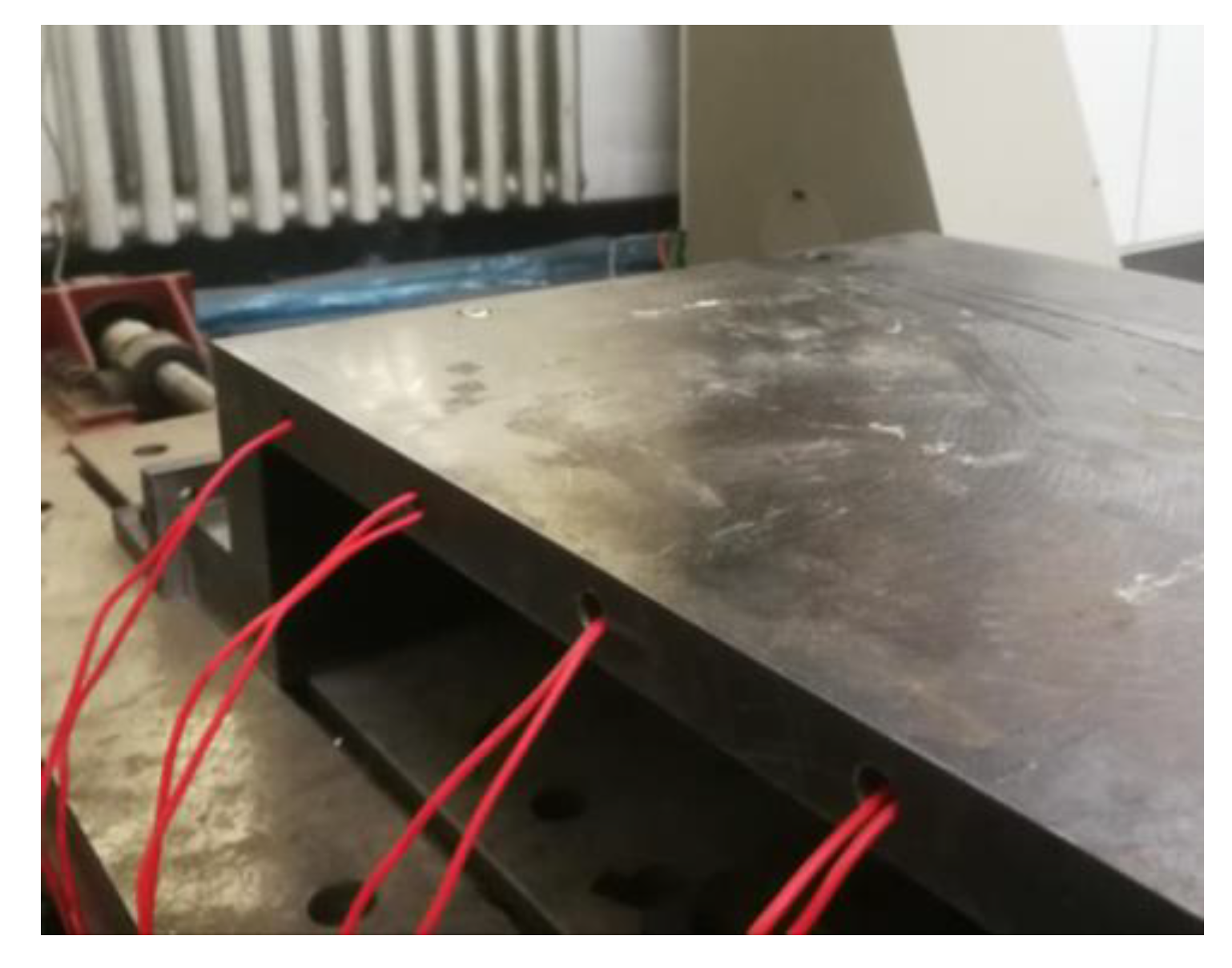
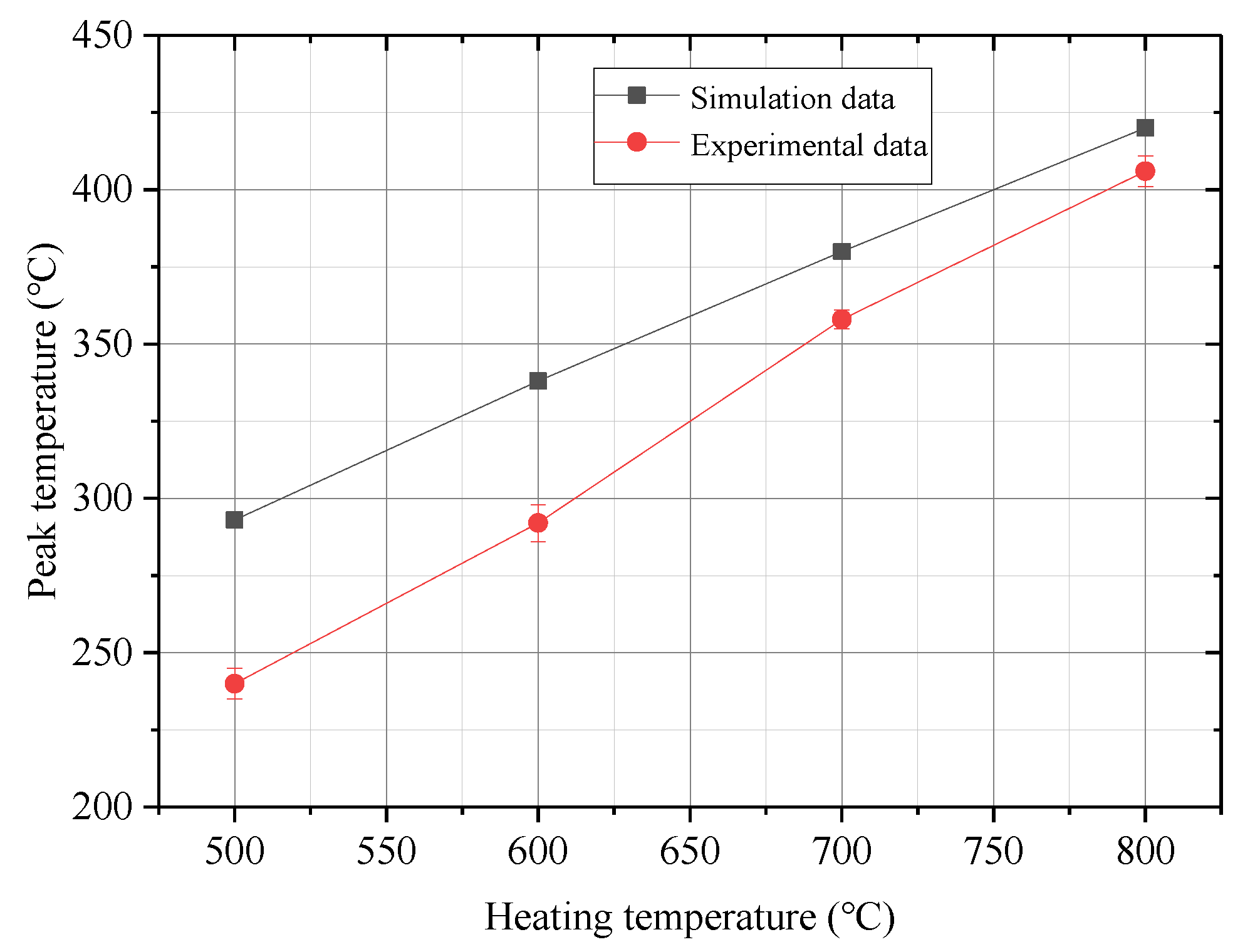
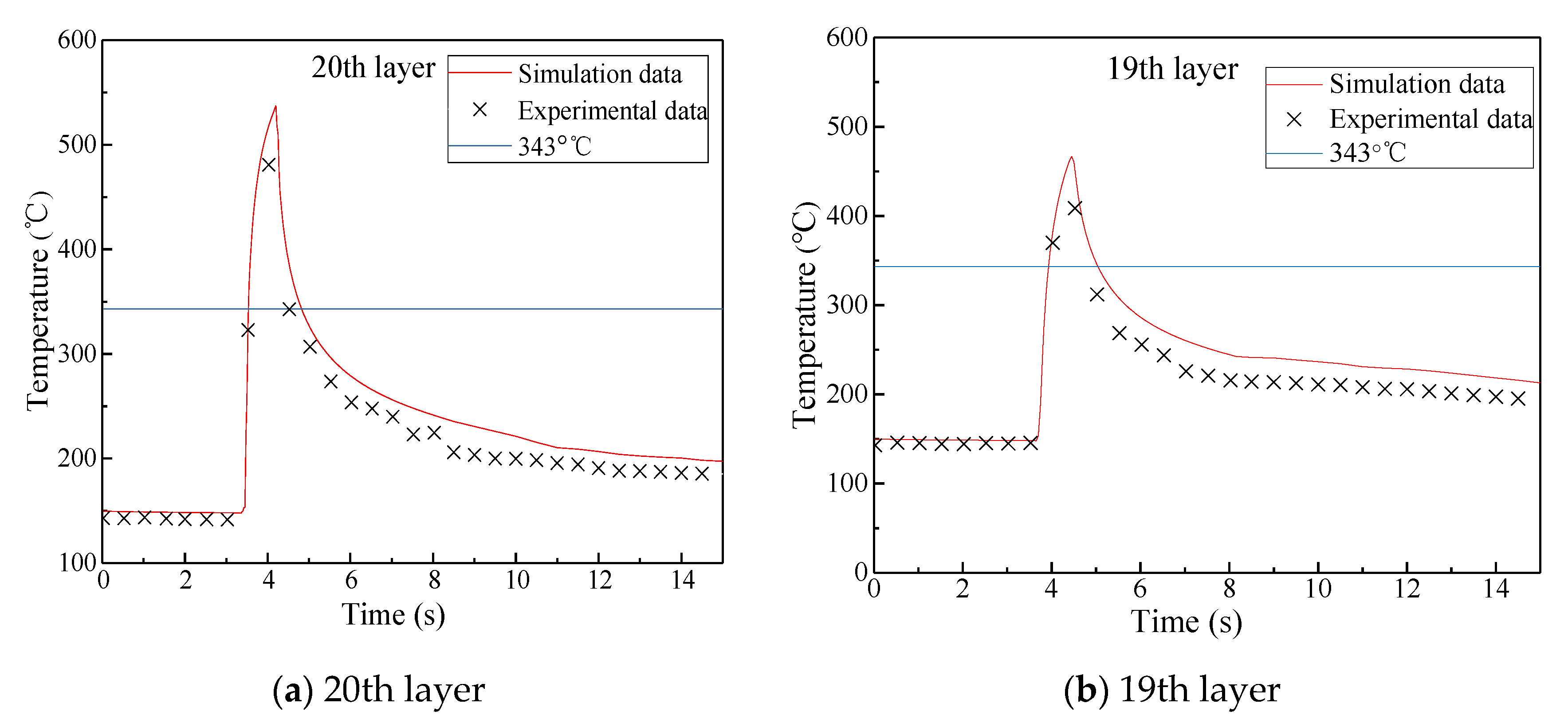
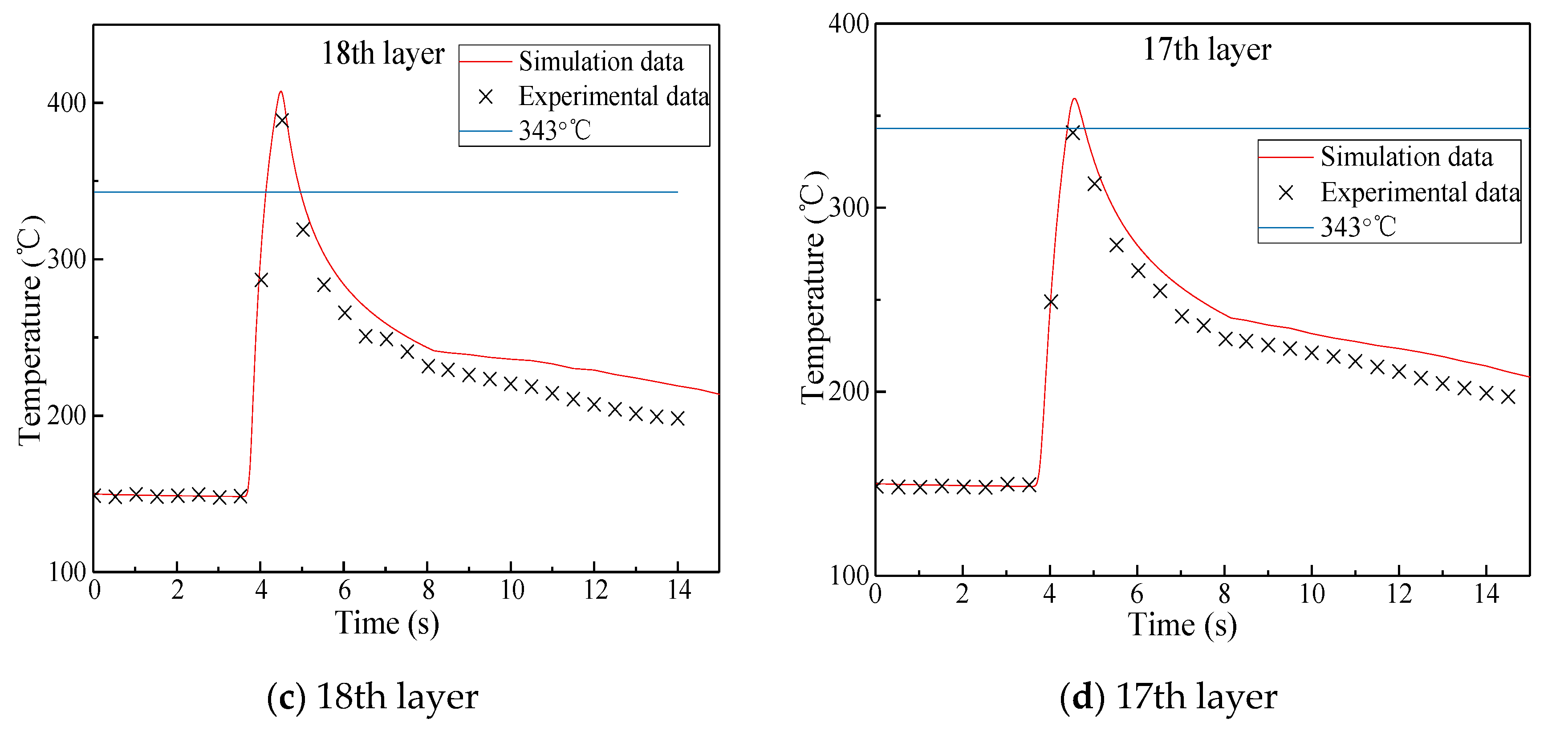
| Parameters | Unit | AS4/PEEK |
|---|---|---|
| Density ρ | kg/m3 | 1560 |
| Specific heat capacity C | J/(kg·°C) | 1425 |
| Thermal conductivity K | W/(m·°C) | Kx = 6 Ky = 0.72 |
| Glass transition temperature Tg | °C | 143 |
| Melting temperature Tm | °C | 343 |
| Degradation temperature Td | °C | 580 |
| Layer thickness h | mm | 0.125 |
| Parameters | Values |
|---|---|
| Thermal conductivity K | 45 W/(m·°C) |
| Specific heat capacity C | 470 J/(kg·°C) |
| Density ρ | 7800 kg/m3 |
| Parameter | Value Range | Description |
|---|---|---|
| Thg | 500–850 °C | Heating temperature |
| vx | 2–30 mm/s | Placement speed |
| ha | 10 W/(m·°C) | Ambient heat transfer coefficient |
| hhg | 250 W/(m·°C) | Hot gas heat transfer coefficient |
| Ta | 25 °C | Ambient temperature |
| Tr | 80 °C | The roller temperature |
| D | 46 mm | The roller diameter |
| Tp | 25 °C | Initial temperature of fiber |
| Tm | 150 °C | Initial temperature of substrate |
| Ts | 150 °C | Initial temperature of layer |
| r1 | 10 mm | Contact length on the fusion right |
| r2 | 3 mm | Contact length on the fusion left |
| wl | 15 mm | Heated length |
© 2020 by the authors. Licensee MDPI, Basel, Switzerland. This article is an open access article distributed under the terms and conditions of the Creative Commons Attribution (CC BY) license (http://creativecommons.org/licenses/by/4.0/).
Share and Cite
Cao, Z.; Dong, M.; Liu, K.; Fu, H. Temperature Field in the Heat Transfer Process of PEEK Thermoplastic Composite Fiber Placement. Materials 2020, 13, 4417. https://doi.org/10.3390/ma13194417
Cao Z, Dong M, Liu K, Fu H. Temperature Field in the Heat Transfer Process of PEEK Thermoplastic Composite Fiber Placement. Materials. 2020; 13(19):4417. https://doi.org/10.3390/ma13194417
Chicago/Turabian StyleCao, Zhongliang, Mingjun Dong, Kailei Liu, and Hongya Fu. 2020. "Temperature Field in the Heat Transfer Process of PEEK Thermoplastic Composite Fiber Placement" Materials 13, no. 19: 4417. https://doi.org/10.3390/ma13194417
APA StyleCao, Z., Dong, M., Liu, K., & Fu, H. (2020). Temperature Field in the Heat Transfer Process of PEEK Thermoplastic Composite Fiber Placement. Materials, 13(19), 4417. https://doi.org/10.3390/ma13194417






